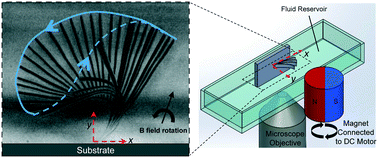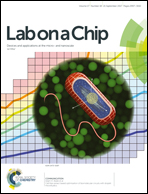Asymmetric motion of magnetically actuated artificial cilia†
Abstract
Most microorganisms use hair-like cilia with asymmetric beating to perform vital bio-physical processes. In this paper, we demonstrate a novel fabrication method for creating magnetic artificial cilia capable of such a biologically inspired asymmetric beating pattern essential for inducing microfluidic transport at low Reynolds number. The cilia are fabricated using a lithographic process in conjunction with deposition of magnetic nickel–iron permalloy to create flexible filaments that can be manipulated by varying an external magnetic field. A rotating permanent magnet is used to actuate the cilia. We examine the kinematics of a cilium and demonstrate that the cilium motion is defined by an interplay among elastic, magnetic, and viscous forces. Specifically, the forward stroke is induced by the rotation of the magnet which bends the cilium, whereas the recovery stroke is defined by the straightening of the deformed cilium, releasing accumulated elastic potential energy. This difference in dominating forces acting during the forward stroke and the recovery stroke leads to an asymmetric beating pattern of the cilium. Such magnetic cilia can find applications in microfluidic pumping, mixing, and other fluid handling processes.



 Please wait while we load your content...
Please wait while we load your content...